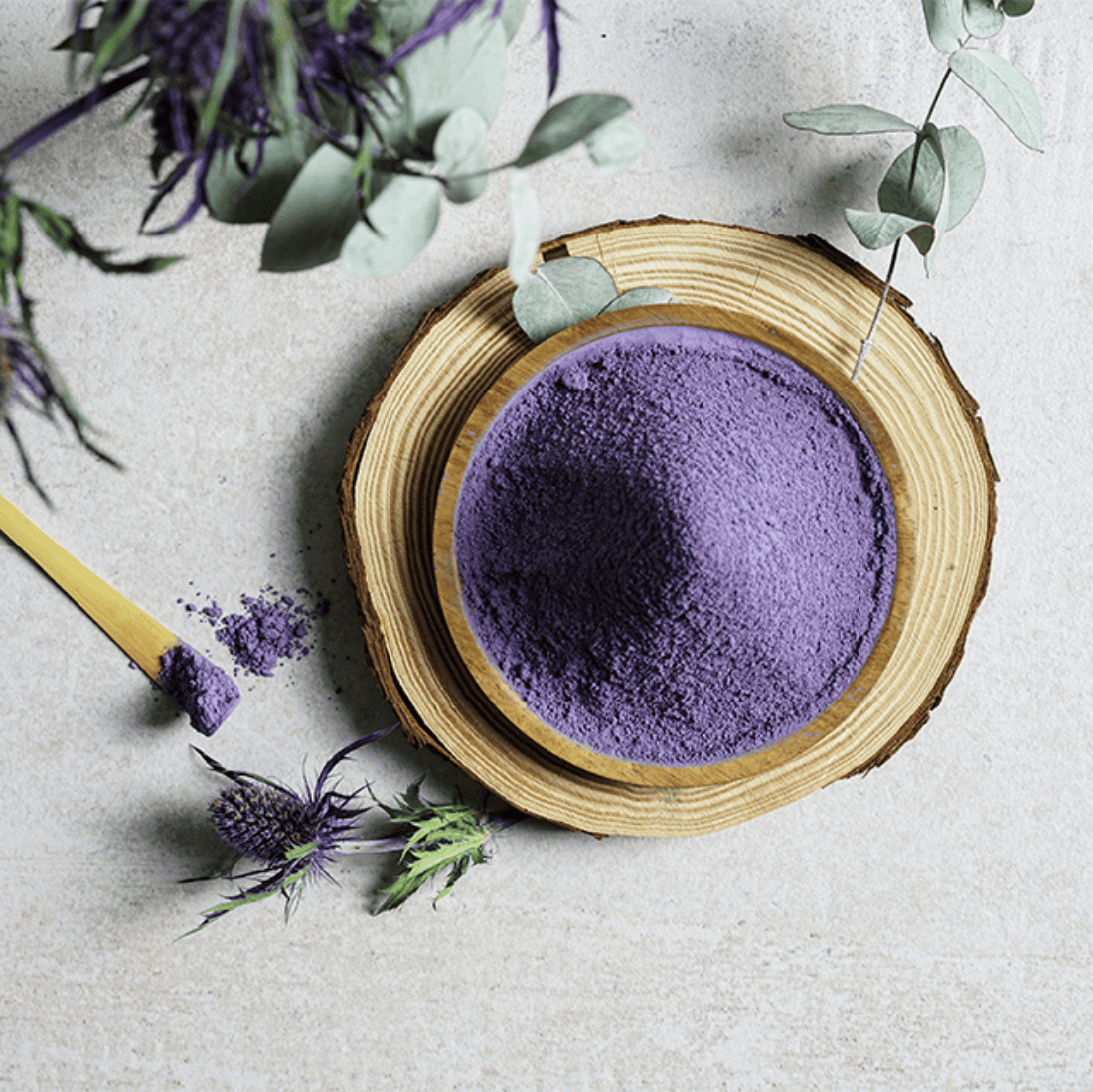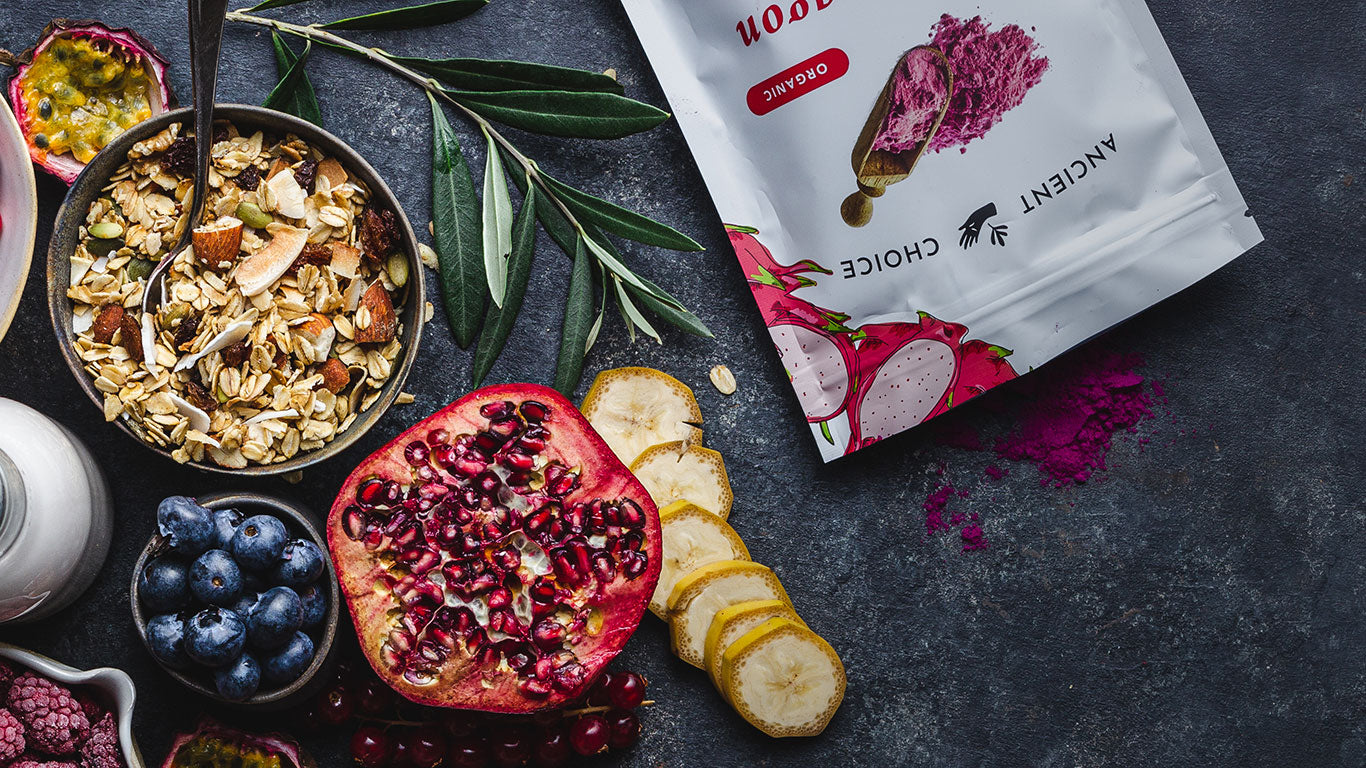
Did you know that matcha, made from green tea leaves, can be ground finer than flour? That level of fineness defines its quality and premium value, often recognized as ceremonial grade.
And blue matcha is no different. The way flowers are milled determines everything, from the flavor to how easily the body absorbs the benefits of butterfly pea flowers.
This is where grind size comes in. It may seem like a small detail at first, but take a sip, and suddenly it’s obvious. It’s what separates an average cup from one that’s cut above the rest.
In this article, we’ll walk through why grind size matters for blue matcha powder, what happens with coarse, medium, fine, and extra fine grinds, and what that means for your drink.
By the end, you’ll know exactly what to look for so you can bring home the kind of powder that actually delivers café-quality blue matcha lattes—or any other recipe you want to recreate.
Table of contents
What is Extra Fine Grind Blue Matcha Powder

Think about how different a French press coffee tastes compared to an espresso. They’re the same beans, but the experience is different because the grind changes everything.
The same idea applies to traditional matcha or blue matcha powder. Instead of coffee beans, it’s the dried leaves of flowers being milled.
Grind size decides how easily the powder mixes into batters, how smooth the drink feels when you sip it, and even how well your body can absorb the beneficial compounds inside.
There are a few grind levels out there, but extra fine is considered a signal for high quality.
Ceremonial powders are almost always finely ground because they blend smoothly into recipes, bringing a creamier texture, more vibrant color, and richer flavor.
And if you are wondering what actually controls grind size, it depends on three things: the milling process, the time and precision of grinding, and the raw material itself. Let’s break it down:
Milling Process
There are a few methods used for milling, such as stone-milling, jet-milling, and industrial milling, and each one delivers a different particle size.
Some use heat, which can dull the color and flavor. Others are slower and only handle small batches, but preserve nutrients and flavor better.
It’s a bit like comparing fast food and home-cooked meals. Both feed you, but only one has all the flavor and care that makes it special.
Time and Precision of Grinding
Even with the right equipment, grind size also depends on how long and carefully the milling is done.
A slow, precise process breaks down the particles evenly, creating a fine powder.
If it’s done too quickly, it can leave behind uneven particles, which won’t mix well later on—whether used to whip up a blue pancake batter for breakfast or make a dalgona blue matcha to unwind.
To get a premium result, the process has to be slow, controlled, and with minimal heat. That’s what makes it possible to create the kind of ultra-fine powder that makes blue matcha a unique drink.
The Raw Material
Of course, none of this matters if the raw material isn’t good.
The quality of the butterfly pea flowers at harvest directly determines how well the powder keeps its signature vibrant shade and subtle flavor once it’s finely milled.
Drying is just as important. If the flowers retain too much moisture, they won’t grind evenly and may form clumps.
In other words, extra fine grind blue matcha powder is not just about reducing petals to powder.
It’s about achieving a consistent fineness that provides a silky texture, bright color, and delicious flavor for every recipe it’s used in.
Why Grind Size Matters in Blue Matcha

Grind size isn’t just a technical thing. It’ll determine powder suspension, flavor, texture, and even nutrient absorption.
With an extra fine grind, more surface area touches the mixture, and the powder does its job way more effectively.
Coarse or medium grind powders tend to clump. Think of it like tossing sand into water, it doesn’t dissolve, nor does it even float. The heavy clumps will sink, leaving sediments at the bottom of the cup.
If you’ve ever finished a latte and found a muddy layer at the bottom, that’s exactly what a coarse grind leaves behind.
On the other hand, fine particles are light. You don’t need to whisk too hard or for too long, and they can stay suspended in the liquid for much longer.
The result is a drink with an even, creamy texture, instead of gritty. It will release more flavor, more color, and extract nutrients better.
For a real-life example, here’s a blue matcha powder that has been finely milled and produces beautiful, smooth drinks with that signature bright blue shade.
Now, let’s compare each grinding size to better understand its differences.
Coarse vs. Medium vs. Fine vs. Extra Fine
Not all blue matcha powders are milled the same way, and the difference shows up right away in the cup.
If you’ve ever heard of green matcha being labeled culinary, premium, or ceremonial grade, those terms basically describe grind size and how each one is best used.
Blue matcha doesn’t officially classify for these grades, as it comes from a different tradition, but the idea still applies when we talk about quality and usage.
Let’s start at the roughest end of the spectrum and work our way toward the extra fine powder that defines the highest quality.
-
Coarse Grind
Coarse grind powders are made up of larger, heavier particles. They don’t dissolve that easily, and also sink fast, leaving clumps, and creating a gritty texture when used in beverages.
It might be fine for baking or other culinary uses, if you’re willing to accept clumps and uneven distribution. But it’s definitely not ideal for lattes, teas, batters, or anything that requires a silky finish.
-
Medium Grind
A medium grind will blend better than a coarse one, but it’s still not ideal for recipes, and especially drinks that need smooth suspension.
You’ll usually notice some sediment at the bottom of the cup or a slightly chalky feeling when you sip.
This grind works better in smoothies, blended drinks, or recipes where its texture gets masked.
-
Fine Grind
A fine grind powder has smaller particles than a medium grind, and you'll notice the difference right away.
The powder blends more evenly, with fewer clumps and a cleaner taste. It's good enough for most recipes, but you still won’t get quite the flawless finish you’d want in a recipe.
That’s where the extra fine grind takes things to the next level.
-
Extra Fine Grind
Extra fine particles are light, uniform, and stay suspended in liquid much longer.
You get vibrant and creamy results, without sediments or grittiness.
Flavor compounds and pigments also release more effectively, so the color looks brighter and the taste is better.
On top of that, the nutrients are easier for the body to absorb, as fine particles facilitate the transfer of vitamins, minerals, and antioxidants into the bloodstream.
Benefits of Extra Fine Grind Blue Matcha Powder

Let’s find out what makes an extra fine grind blue matcha worth it.
Creamier Texture
We definitely want to avoid a chalky or sandy feeling at all costs when enjoying a drink, right?
That usually comes from larger particles that don’t break down completely.
When blue matcha powder is milled extra fine, the particles are so small that they disperse easily.
In fact, that’s why ceremonial matcha powders, whether green or blue, are always milled extra fine, because it’s the only way to achieve that velvety texture people currently associate with high quality.
Better Particle Suspension
Here’s where we go deeper into physics.
Smaller particles weigh less, so they don’t sink to the bottom as quickly as coarse powders or medium ground powders.
With extra fine blue matcha, the powder actually stays suspended in liquid longer, which means less whisking and less stirring.
That’s the only way for a drink to stay consistent from the first sip to the last.
A medium grind might look fine at first, but over time it sinks, leaving a muddy layer at the bottom.
The same goes for recipes, whether it’s stirred into pudding, folded into cake batter, or worked into cookie dough, a medium grind leaves tiny clumps that never fully blend in.
An extra fine grind avoids that problem, no matter what mix or recipe it is used in.
Richer Flavor and Color
The finer the grind, the more of the particle’s surface is exposed.
More surface area means a stronger extraction of its properties, so pigments, antioxidants, and flavor compounds are released more efficiently.
That’s why extra fine blue matcha powder produces a deeper blue color and a better taste.
Using a medium or coarse grind, you miss out on some of those compounds. You may get a dull blue color, as the pigments stay locked inside the larger fragments instead of infusing into your drink.
Easier Nutrient Absorption
And last but definitely not least, the nutritional side.
Grind size directly impacts bioavailability, which refers to how many nutrients your body can take in.
Extra fine powders break down into particles small enough that our digestive system can access antioxidants such as anthocyanins, polyphenols, and flavonoids more effectively.
That means in every sip, you get more of the butterfly pea flower's benefits.
With a coarse grind, much of that potential remains trapped inside the larger particles and simply passes through the body unused.
Why Choose Extra Fine Grind Blue Matcha

At the end of the day, it all comes down to the experience you want.
After looking at coarse, medium, fine, and extra fine grinds, the difference is clear.
Coarse powders may work in baking, and a medium grind might blend into a smoothie, but neither gives you the smooth suspension or silky texture that makes a recipe feel premium.
With a finely ground blue matcha powder, you get it all in one: bright color, smooth texture, rich flavor, and better antioxidant absorption.
It’s simply the best blue matcha powder to get the kind of café-quality experience you actually want to enjoy at home.






